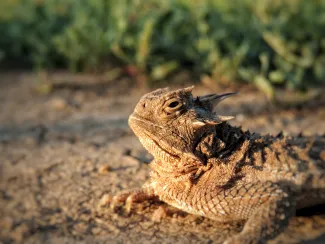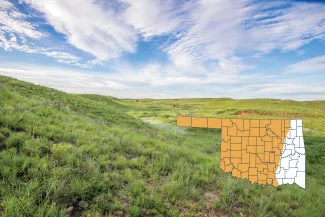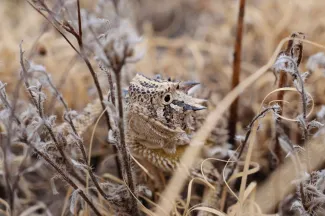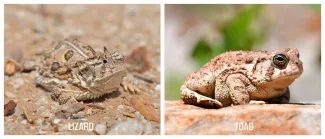Texas horned lizards, or the more familiar “horned toads,” hold a special interest for many outdoor enthusiasts. They often feature fondly in childhood memories, spark a curiosity about the natural world, and can bring excited smiles when encountered. But these tank-like animals aren’t stumbled upon as frequently as they have been in the past. We checked in with biologists Mark Howery and Cheyenne Gonzales to answer a few of the Wildlife Department’s most frequently asked lizard questions and learn how to best help these well-loved reptiles.

Where Did They Go?
Historically, Texas horned lizards were found across about 80% of Oklahoma’s counties, foraging in native grasslands for ants and other insects during their active season and burrowing underground to avoid extreme temperatures. But the lizards have become increasingly scarce as more and more of their habitat has been converted to crop fields and non-native pastures.
“Texas horned lizards are undoubtedly experiencing declines,” said Mark Howery, senior biologist with the Wildlife Department’s Wildlife Diversity Program. “But they continue to be locally common and widespread in the western one-third of the state.
“And while we’ve seen the most substantial declines in the central and eastern parts of their range, one of the fascinating things about the reports we receive from the public is that the lizards continue to persist in pockets, especially in central Oklahoma.”
This persistence is likely due to corresponding pockets of quality lizard habitat.

Texas horned lizards were historically found across much of the western two-thirds of Oklahoma and continue to persist in open, native habitat, including at Ellis County Wildlife Management Area. Photo by Kelly Adams.
“Texas horned lizards need somewhat loose soils, with relatively open vegetation and exposed ground to thrive,” said Cheyenne Gonzales, another biologist with the Wildlife Diversity Program. “They’re sit-and-wait predators, relying on their camouflage to avoid being spotted by predators and waiting for ants next to their open trails.”
Are They Protected or Endangered?
Contrary to popular belief, the Texas horned lizard isn’t a “listed” species but is afforded some protections by state law.
“These lizards are neither threatened or endangered at the state or federal level,” Gonzales said. “Instead, they’re considered a species of greatest conservation need and have a closed season in Oklahoma.”
The closed season has protected Texas horned lizards from direct take – capture, possession, or harvest – since 1992, and while the protection doesn’t extend to the lizard’s habitat, it does make it illegal to keep one as a pet.
“A majority of the lizard's diet is ants and other insects,” Gonzales said. "Even if it were legal to have a Texas horned lizard, it would be difficult to supplement its diet and keep it alive.”
How Can I Help Lizards?
Lizard enthusiasts have many options for helping lizards and other wildlife, from maintaining quality places for them to live, to reducing the risk of predation or mortality, to simply sharing the word.
“The first and foremost way to help Texas horned lizards is to conserve their habitat,” Howery said. “It all starts with native vegetation.”

Native vegetation – with plenty of bunch grasses and flowering plants – doesn’t just help the lizards more easily move around their environment, it helps the lizard’s main food source, ants.
“Harvester ants are feeding on the seeds of these grasses and forbs, and while people may avoid spraying ant mounds with insecticide, they may not realize that spraying ‘weeds’ with herbicide can be just as detrimental to the lizards and their food supply.”
Keeping bermudagrass and other invasive, sod-forming grass at bay is another way to accommodate lizards.
“Horned lizards will spend time in mowed bermudagrass yards to bask in the sun and warm up, but they can’t live there full time,” warns Howery. “Bermudagrass doesn't produce enough seeds to support harvester ants, and tall bermudagrass is difficult for horned lizards to move through. Keeping bermudagrass out of lizard habitat is key to maintaining the ideal combination of native vegetation and bare ground.”
Private landowners can get more tips for maintaining habitat for lizards, or any other native wildlife, by scheduling a visit with the Wildlife Department’s Private Lands Program.
I have native grass and ants…where can I get lizards?
Landowners that have both native habitat and ample ant mounds often reach out to the Wildlife Department to find out how they can relocate horned lizards to their property. Unfortunately, studies show translocated lizards and other reptiles experience high mortality – fewer than 25% of relocated Texas horned lizard adults and less than 30% of juveniles survive a full year – making a relocation program unrealistic at this time.
“Relocated animals have a hard time orienting in and learning their new environment,” Howery said. “Studies show these individuals move four to five times more often in their new habitat than the resident horned lizards. That makes them incredibly susceptible to predation.”
Even without the issue of increased mortality of translocated animals, the issue of scale remains.
“They may be relatively small in size, but these lizards require a large amount of quality habitat. For some species, we can implement practices in our backyard and make an impact. But for Texas horned lizards, a relocation area would need to support several hundred lizards to make an impact, and that can require more than 100 acres of high-quality habitat.
“The good news is that if you have quality habitat in a large tract, there’s a good chance that you already have lizards on your property.”
While habitat is the major factor in maintaining horned lizard populations, there are multiple other ways to help the lizards.
“If you’re trying to control fire ants, you can use 3 gallons of boiling water per mound instead of insecticides that may affect native invertebrates,” Gonzales said. “And keeping house cats indoors can also protect lizards and other wildlife from predation.
“Don’t forget that roads can be a dangerous place for basking lizards and other small animals. You can help reduce road mortality by being mindful when traveling, especially on dirt and pasture roads.”
Howery and Gonzales also encourage people to share their Texas horned lizard sightings at wildlifedepartment.com.
“In the last two years, we’ve received reports of more than 500 individual lizards, more than half of which have been juveniles, from 39 counties,” Gonzales said. “It’s always great to get these reports and keep tabs on the population.”
Lizard or Toad?

Part of the Texas horned lizard’s scientific name, “Phrynosoma,” translates to “toad body.”
Despite the popular common name of “horned toad,” these animals are technically lizards. Both lizards and toads feed primarily on insects, but only the reptilian lizards have scales on their bodies, claws on their feet, and most have external ear openings. Toads and other amphibians have moist skin, which is usually smooth, lack claws, and do not have external ear openings.
“Texas horned lizards are more adapted to drier environments than most reptiles and amphibians, but they likely have higher water requirements than we think,” Howery said. “In fact, these lizards can funnel rain and dew down channels of scales on their back toward their mouths to drink or ‘harvest’ that moisture.”
What is the Wildlife Department Doing for Texas Horned Lizards?
In addition to collecting Texas horned lizard sightings from the public and monitoring their status, the Wildlife Department has funded multiple studies focused on the popular lizard and manages hundreds of thousands of acres of public lands that benefit lizards and other wildlife.
“We’ve worked with several partners at the University of Oklahoma, the Sam Noble Museum of Natural History, the Oklahoma City Zoo, and Oklahoma State University to learn more about these lizards, where they occur, and the potential viability of a relocation program,” Howery said. “And one of our current projects is assessing the most effective ways to survey lizards on public and private lands. Early indicators point to road-based surveys as the most effective survey method.”
Beyond this study, funded in part by the State Wildlife Grants program with support from partners like the University of Oklahoma, the Wildlife Department also manages habitat that can support Texas horned lizards on 36 Wildlife Management Areas, encompassing more than 325,000 acres of public lands. And the agency encourages and financially supports similar habitat management practices, including prescribed fire and native grass plantings, on privately owned lands.
“Conserving this species in Oklahoma is going to take long-term commitment and efforts from multiple partners at multiple levels,” Howery said. “The Wildlife Department has made strides by having protective regulations and managing habitat on public lands. But it will take a landscape scale effort – with private landowners as our chief partner – to make an impact.”